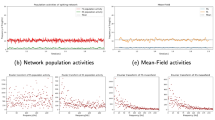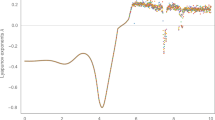Abstract
The Feynman machine is a unique model expressing spiking-timing-dependent neural interactions through path integrals. It provides the capability to predict neural firing statistics very precisely. If time-ordered neural interactions are to be represented more properly, however, the classical form of the model needs to be improved. We here introduce how to describe neural interactions by adopting the second quantization formalism; this is requisite for expressing adequately the firing states deviating from a reference state and for calculating firing statistics through a perturbation method. The formulation is also helpful in picking out the neural firings with causal relationships and in predicting activations of a neural network in response to a given external input. This capability is essential for describing the function of a neural network based on the relationship between the input and the output firing patterns.
Similar content being viewed by others
References
P. Dayan and L. F. Abbott, Theoretical Neuroscience (MIT Press, London, 2001).
W. Gerstner and W. M. Kistler, Spiking Neuron Models (Cambridge University Press, New York, 2002).
W. Gerstner, W. M. Kistler and R. Naud, Neuronal Dynamics (Cambridge University Press, New York, 2014).
H. Markram, J. Lubke, M. Frotscher and B. Sakamann, Science 275, 213 (1997).
L. Zhang et al., Nature 95, 37 (1998).
G-Q. Bi and M-M. Poo, J. Neurosci. 18, 10464 (1998).
L. F. Abbott and S. B. Nelson, Nat. Neurosci. 3, 1178 (2000).
M. W. Cho and M. Y. Choi, Europhys. Lett. 115, 38001 (2016).
M. W. Cho, J. Korean Phys. Soc. 71, 222 (2017).
J. J. Hopfield, Proc. Natl. Acad. Sci. U.S.A. 79, 2554 (1982).
D. H. Ackley, G. Hinton and T. Sejnowski, Cogn. Sci. 9, 147 (1985).
M. W. Cho, J. Korean Phys. Soc. 73, 1385 (2018).
G. E. Uhlenbeck and L. S. Ornstein, Phys. Rev. 36, 823 (1930).
H. Risken, Fokker-Plank Equation: Method of Solution and Applications (Springer-Verlag, New York, 1989).
M. W. Cho, New Phys.: Sae Mulli 67, 862 (2017).
M. W. Cho, New Phys.: Sae Mulli 69, 874 (2019).
Acknowledgments
This work was supported by the Sungshin Women’s University Research Grant of 2018-1-21-012/1. M.Y.C. also acknowledges the support from the National Research Foundation of Korea through the Basic Science Research Program (Grant No. 2019R1F1A1046285).
Author information
Authors and Affiliations
Corresponding authors
Rights and permissions
About this article
Cite this article
Cho, M.W., Choi, M.Y. Response Theory of Spiking Neural Networks. J. Korean Phys. Soc. 77, 168–176 (2020). https://doi.org/10.3938/jkps.77.168
Received:
Revised:
Accepted:
Published:
Issue Date:
DOI: https://doi.org/10.3938/jkps.77.168




